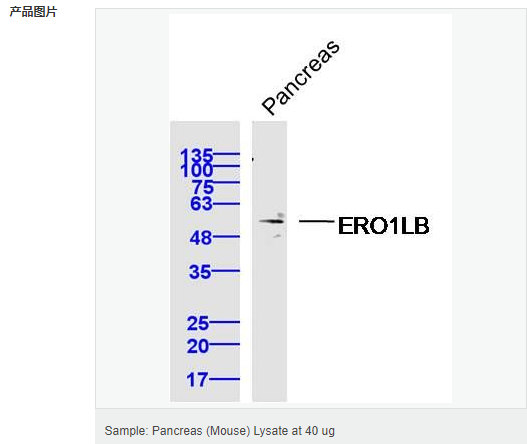

貨號
產品規格
售價
備注
BN40449R-100ul
100ul
¥2360.00
交叉反應:Mouse(predicted:Human,Rat,Rabbit,GuineaPig) 推薦應用:WB,ELISA
BN40449R-200ul
200ul
¥3490.00
交叉反應:Mouse(predicted:Human,Rat,Rabbit,GuineaPig) 推薦應用:WB,ELISA
產品描述
| 英文名稱 | ERO1LB |
| 中文名稱 | Ero1-Lβ蛋白抗體 |
| 別 名 | Endoplasmic oxidoreductin-1-like protein B; ERO1-L-beta; ERO1B_HUMAN; ERO1-like protein beta; Oxidoreductin-1-L-beta. |
| 研究領域 | 細胞生物 信號轉導 轉運蛋白 |
| 抗體來源 | Rabbit |
| 克隆類型 | Polyclonal |
| 交叉反應 | Mouse, (predicted: Human, Rat, Rabbit, Guinea Pig, ) |
| 產品應用 | WB=1:500-2000 ELISA=1:5000-10000 not yet tested in other applications. optimal dilutions/concentrations should be determined by the end user. |
| 分 子 量 | 50kDa |
| 細胞定位 | 細胞漿 |
| 性 狀 | Liquid |
| 濃 度 | 1mg/ml |
| 免 疫 原 | KLH conjugated synthetic peptide derived from human ERO1LB:1-100/467 |
| 亞 型 | IgG |
| 純化方法 | affinity purified by Protein A |
| 儲 存 液 | 0.01M TBS(pH7.4) with 1% BSA, 0.03% Proclin300 and 50% Glycerol. |
| 保存條件 | Shipped at 4℃. Store at -20 °C for one year. Avoid repeated freeze/thaw cycles. |
| PubMed | PubMed |
| 產品介紹 | Essential oxidoreductase that oxidizes proteins in the endoplasmic reticulum to produce disulfide bonds. Acts by oxidizing directly P4HB/PDI isomerase through a direct disulfide exchange. Does not act as a direct oxidant of folding substrate, but relies on P4HB/PDI to transfer oxidizing equivalent. Associates with ERP44 but not with GRP54, demonstrating that it does not oxidize all PDI related proteins and can discriminate between PDI and related proteins. Its reoxidation probably involves electron transfer to molecular oxygen via FAD. Acts independently of glutathione. May be responsible for a significant proportion of reactive oxygen species (ROS) in the being a source of oxidative stress. Required for the folding of cell, thereby being a source of oxidative stress. Function: Oxidoreductase involved in disulfide bond formation in the endoplasmic reticulum. Efficiently reoxidizes P4HB/PDI, the enzyme catalyzing protein disulfide formation, in order to allow P4HB to sustain additional rounds of disulfide formation. Other protein disulfide isomerase family members can also be reoxidized, but at lower rates compared to P4HB, including PDIA2 (50% of P4HB reoxidation rate), as well as PDIA3, PDIA4, PDIA6 and NXNDC12 (<10%). Following P4HB reoxidation, passes its electrons to molecular oxygen via FAD, leading to the production of reactive oxygen species (ROS) in the cell. May be involved in oxidative proinsulin folding in pancreatic cells, hence may play a role in glucose homeostasis. Subunit: Homodimer; disulfide-linked. Heterodimer with ERO1L; disulfide-linked. Also detected as monomer. Homodimers may be somewhat less active than monomers. Interacts with P4HB. Interacts with ERP44. Subcellular Location: Endoplasmic reticulum membrane; Peripheral membrane protein; Lumenal side. Note: The association with ERP44 may be essential for its retention in the endoplasmic reticulum. Tissue Specificity: Highly expressed in the digestive tract, including the duodenum and lower digestive tract. In the stomach, highly expressed in enzyme-producing chief cells (at protein level). In the pancreas, expressed in islets of Langerhans and, at lower levels, in enzyme-secreting cells (at protein level). Detected at low level in many other tissues. Post-translational modifications: N-glycosylated. The Cys-90/Cys-95 and Cys-393/Cys-396 disulfide bonds constitute the redox-active center. The Cys-90/Cys-95 disulfide bond accepts electron from P4HB and funnel them to the active site disulfide Cys-393/Cys-396. The Cys-81/Cys-390 disulfide bond may be critical for structural stability. Two long-range disulfide bonds participate in loose feedback regulation. The Cys-90/Cys-130 disulfide bond may be the predominant regulatory switch to modulate the catalytic activity, while the Cys-100/Cys-262 disulfide bond may play an auxiliary regulatory role. Similarity: Belongs to the EROs family. SWISS: Q86YB8 Gene ID: 56605 Database links: Entrez Gene: 56605 Human SwissProt: Q86YB8 Human Important Note: This product as supplied is intended for research use only, not for use in human, therapeutic or diagnostic applications. |

